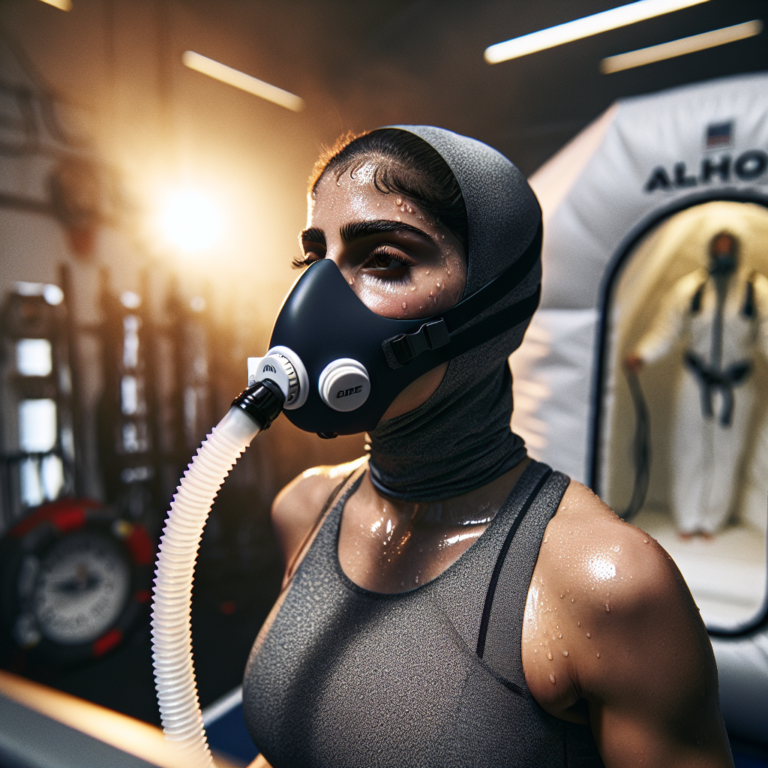Table of Contents
ToggleAltitude or Hypoxic Training
Key Takeaways
- Altitude or hypoxic training exposes athletes to reduced oxygen levels, triggering physiological adaptations
- Benefits include improved aerobic capacity, enhanced endurance, and increased VO2max
- Various protocols exist, such as Live High, Train High (LHTH) and Live High, Train Low (LHTL)
- Optimal “hypoxic dose” depends on altitude levels, exposure duration, and training frequency
- Practical considerations include acclimatization, nutrition, and potential risks like overtraining

Introduction to Altitude or Hypoxic Training
In the world of sports and endurance performance, athletes are constantly seeking innovative methods to gain a competitive edge. One such method that has gained significant attention is altitude training or hypoxic training. This training approach leverages the body’s adaptations to reduced oxygen levels, potentially leading to enhanced athletic performance.
Understanding Altitude or Hypoxic Training
What is Altitude or Hypoxic Training?
Altitude or hypoxic training is a method where athletes expose themselves to reduced oxygen levels, either by training at high altitudes or using simulated altitude environments. This exposure triggers physiological adaptations that can improve athletic performance, particularly in endurance-based sports.
Natural vs. Simulated Altitude Training
When it comes to altitude or hypoxic training, athletes and coaches have two primary options: natural altitude training and simulated altitude training. Each approach has its unique characteristics, benefits, and challenges. Let’s dive deeper into these methods to understand how they can impact athletic performance.
There are two primary approaches to altitude or hypoxic training:
- Natural Altitude Training: Athletes travel to and train in high-altitude locations.
- Simulated Altitude Training: Using specialized equipment to create a low-oxygen environment at sea level.
Natural Altitude Training: Embracing the Mountain Air
Natural altitude training involves athletes traveling to and training in high-altitude locations, typically at elevations between 1,500 to 3,000 meters (4,900 to 9,800 feet) above sea level. This method exposes athletes to the real-world conditions of high-altitude environments.
Advantages of Natural Altitude Training:
- Complete Environmental Exposure: Athletes experience all aspects of high-altitude living, including reduced air pressure, lower oxygen levels, and often drier air.
- 24/7 Adaptation: The body undergoes continuous adaptation, even during rest and sleep periods.
- Psychological Benefits: The change of scenery and environment can provide mental refreshment and focus.
- Additional Stressors: Factors like UV exposure and temperature variations can enhance overall physiological adaptations.
Challenges of Natural Altitude Training:
- Logistical Complexity: Requires travel, which can be expensive and time-consuming.
- Limited Locations: Not all athletes have easy access to suitable high-altitude training sites.
- Reduced Training Intensity: The lower oxygen levels can initially decrease the ability to train at high intensities.
- Altitude Sickness: Some athletes may experience symptoms of acute mountain sickness, especially in the early days.
Challenges of Simulated Altitude Training:
- Limited Exposure Time: Most athletes only use simulated altitude for a few hours per day.
- Lack of Additional Environmental Factors: Misses out on other high-altitude stressors that may contribute to adaptations.
- Equipment Dependency: Relies on the proper functioning and maintenance of hypoxic devices.
- Potential for Misuse: Incorrect use of equipment can lead to inadequate or excessive exposure.

The Science Behind Altitude or Hypoxic Training
The science behind altitude or hypoxic training is fascinating and involves several physiological adaptations that occur in the body when exposed to low-oxygen environments. These adaptations contribute to improved athletic performance and endurance.
Physiological Adaptations
When exposed to high altitudes or hypoxic conditions, the body undergoes several key adaptations:
- Increased red blood cell production: The body produces more erythropoietin (EPO), which stimulates the production of red blood cells. This leads to a higher oxygen-carrying capacity in the blood.
- Enhanced lung function: The respiratory rate and depth of breathing increase to compensate for the lower oxygen levels, improving overall lung capacity and efficiency.
- Improved oxygen utilization: Muscles develop more capillaries and mitochondria, allowing for better oxygen extraction and utilization at the cellular level.
- Increased anaerobic threshold: The body becomes more efficient at using oxygen, allowing athletes to perform at higher intensities before reaching their anaerobic threshold.
- Elevated hematocrit levels: The percentage of red blood cells in the blood increases, further enhancing oxygen-carrying capacity.
Mechanisms of Adaptation
The body’s response to hypoxic conditions is primarily driven by the hypoxia-inducible factor (HIF) pathway. This pathway activates genes responsible for various adaptations, including:
- Increased production of EPO
- Enhanced angiogenesis (formation of new blood vessels)
- Improved glucose metabolism
- Upregulation of enzymes involved in anaerobic metabolism
These adaptations collectively contribute to improved oxygen delivery and utilization in the body, leading to enhanced athletic performance, particularly in endurance sports.
Benefits for Athletic Performance
Altitude or hypoxic training can lead to several performance benefits:
- Increased VO2 max: The maximum rate of oxygen consumption during exercise improves, allowing athletes to perform at higher intensities for longer periods.
- Enhanced endurance: Athletes can maintain higher speeds or power outputs for extended durations due to improved oxygen utilization.
- Faster recovery: The body becomes more efficient at clearing lactate and other metabolic byproducts, leading to quicker recovery between high-intensity efforts.
- Improved mental toughness: Training under challenging conditions can enhance an athlete’s psychological resilience and ability to perform under pressure.
Considerations and Limitations
While altitude or hypoxic training can be beneficial, it’s important to note:
- Individual responses to hypoxic conditions can vary significantly
- Proper acclimatization is crucial to avoid potential negative effects
- The “live high, train low” approach may be more effective for some athletes
- Adequate recovery and nutrition are essential to maximize the benefits of altitude training
Understanding the science behind altitude or hypoxic training allows coaches and athletes to implement these methods effectively, potentially leading to significant improvements in athletic performance, particularly in endurance-based sports.
Benefits of Altitude or Hypoxic Training
Research has shown that altitude or hypoxic training can lead to several performance-enhancing benefits:
- Improved aerobic capacity
- Enhanced endurance performance
- Increased VO2max (maximum oxygen uptake)
- Better microcirculation function
Types of Altitude or Hypoxic Training Protocols
Researchers and coaches have developed various protocols to maximize the benefits of altitude or hypoxic training:
| Protocol | Description | Potential Benefits |
|---|---|---|
| Live High, Train High (LHTH) | Athletes live and train at high altitudes | Comprehensive altitude adaptation |
| Live High, Train Low (LHTL) | Live at altitude, train at lower elevations | Maintain training intensity while adapting to altitude |
| Live Low, Train High (LLTH) | Live at sea level, train at simulated altitude | Altitude benefits without lifestyle disruption |
| Intermittent Hypoxic Training (IHT) | Short, intense exposure to hypoxic conditions | Time-efficient altitude training |
Optimal “Hypoxic Dose” for Altitude or Hypoxic Training
The effectiveness of altitude or hypoxic training depends on several factors:
- Altitude Levels: Typically ranging from 1500m to 3000m above sea level
- Duration of Exposure: Usually 2-4 weeks for significant adaptations
- Frequency of Training Sessions: Varies based on the chosen protocol
Finding the right balance of these factors is crucial for maximizing the benefits while minimizing risks.

Altitude or Hypoxic Training for Different Sports
Endurance Sports
- Long-distance running
- Cycling
- Swimming
Ultra-Endurance Events
- Ultramarathons
- Triathlons
Combat Sports
- Judo
- Wrestling
- Boxing
Each sport may require a tailored approach to altitude or hypoxic training to address specific physiological demands.
Practical Considerations for Altitude or Hypoxic Training
Acclimatization Period
Allow sufficient time for the body to adapt to reduced oxygen levels, typically 1-2 weeks.
Nutrition and Hydration at Altitude
- Increase carbohydrate intake
- Stay well-hydrated
- Consider iron supplementation (under medical supervision)
Recovery and Sleep Quality
Prioritize rest and recovery, as altitude can initially impact sleep quality.
Potential Risks and Limitations of Altitude or Hypoxic Training
While altitude or hypoxic training offers numerous benefits, it’s essential to be aware of potential risks:
- Overtraining syndrome
- Decreased training intensity
- Individual variability in responses
Proper monitoring and individualized approaches can help mitigate these risks.
Case Studies and Research Findings on Altitude or Hypoxic Training
Studies on Rowers
Research has shown improved performance and physiological adaptations in rowers following altitude training camps.
Research on Judo Athletes
Judo athletes have demonstrated enhanced anaerobic performance and recovery following hypoxic training protocols.
Findings from Other Endurance Sports
Numerous studies across various endurance sports have reported improvements in VO2max and time trial performance after altitude or hypoxic training interventions.
Alternatives to Natural Altitude Training
For athletes unable to access natural high-altitude environments, several alternatives exist:
- Hypoxic Chambers: Room-sized facilities that simulate high-altitude conditions
- Altitude Tents: Portable, tent-like structures for sleeping in hypoxic conditions
- Mask-Based Systems: Wearable devices that restrict oxygen intake during exercise
These methods allow athletes to incorporate altitude or hypoxic training into their regimens without relocating to high-altitude areas.
Combining Altitude or Hypoxic Training with Other Methods
To maximize the benefits of altitude or hypoxic training, athletes and coaches often combine it with other training modalities:
Resistance Training at Altitude
Performing strength exercises in hypoxic conditions may enhance muscle adaptations.
Inspiratory Muscle Training
Combining altitude exposure with specific respiratory muscle training can further improve endurance performance.
Conclusion: The Future of Altitude or Hypoxic Training
Altitude or hypoxic training has established itself as a valuable tool in the arsenal of elite athletes and coaches. As research continues to refine our understanding of its mechanisms and optimal protocols, we can expect to see even more sophisticated and personalized approaches to altitude or hypoxic training in the future.
Key areas for future research include:
- Genetic factors influencing individual responses to altitude
- Long-term effects of chronic altitude or hypoxic training
- Integration of altitude training with emerging technologies in sports science
As our knowledge expands, altitude or hypoxic training will likely play an increasingly important role in pushing the boundaries of human athletic performance.




